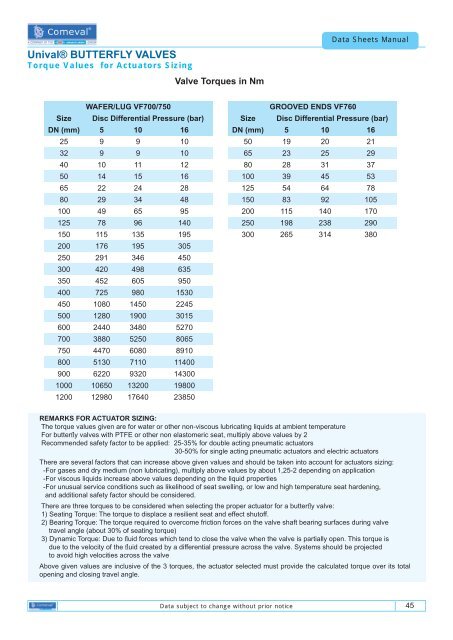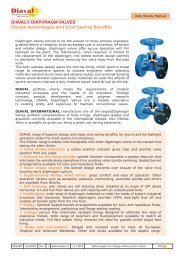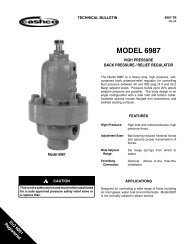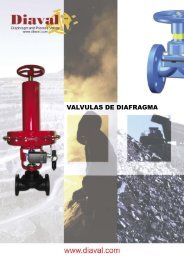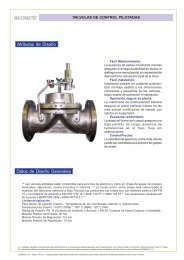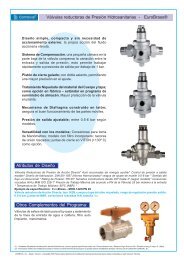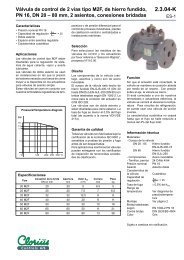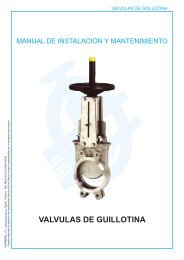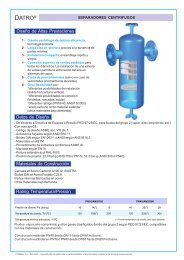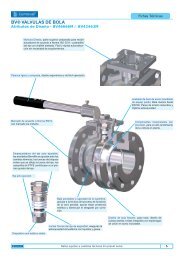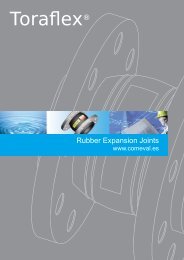Untitled - COMEVAL
Untitled - COMEVAL
Untitled - COMEVAL
You also want an ePaper? Increase the reach of your titles
YUMPU automatically turns print PDFs into web optimized ePapers that Google loves.
Unival® BUTTERFLY VALVES<br />
Torque Values for Actuators Sizing<br />
Valve Torques in Nm<br />
Data Sheets Manual<br />
WAFER/LUG VF700/750<br />
Size Disc Differential Pressure (bar)<br />
DN (mm) 5 10 16<br />
25 9 9 10<br />
32 9 9 10<br />
40 10 11 12<br />
50 14 15 16<br />
65 22 24 28<br />
80 29 34 48<br />
100 49 65 95<br />
125 78 96 140<br />
150 115 135 195<br />
200 176 195 305<br />
250 291 346 450<br />
300 420 498 635<br />
350 452 605 950<br />
400 725 980 1530<br />
450 1080 1450 2245<br />
500 1280 1900 3015<br />
600 2440 3480 5270<br />
700 3880 5250 8065<br />
750 4470 6080 8910<br />
800 5130 7110 11400<br />
900 6220 9320 14300<br />
1000 10650 13200 19800<br />
1200 12980 17640 23850<br />
GROOVED ENDS VF760<br />
Size Disc Differential Pressure (bar)<br />
DN (mm) 5 10 16<br />
50 19 20 21<br />
65 23 25 29<br />
80 28 31 37<br />
100 39 45 53<br />
125 54 64 78<br />
150 83 92 105<br />
200 115 140 170<br />
250 198 238 290<br />
300 265 314 380<br />
REMARKS FOR ACTUATOR SIZING:<br />
The torque values given are for water or other non-viscous lubricating liquids at ambient temperature<br />
For butterfl y valves with PTFE or other non elastomeric seat, multiply above values by 2<br />
Recommended safety factor to be applied: 25-35% for double acting pneumatic actuators<br />
30-50% for single acting pneumatic actuators and electric actuators<br />
There are several factors that can increase above given values and should be taken into account for actuators sizing:<br />
-For gases and dry medium (non lubricating), multiply above values by about 1,25-2 depending on application<br />
-For viscous liquids increase above values depending on the liquid properties<br />
-For unusual service conditions such as likelihood of seat swelling, or low and high temperature seat hardening,<br />
and additional safety factor should be considered.<br />
There are three torques to be considered when selecting the proper actuator for a butterfly valve:<br />
1) Seating Torque: The torque to displace a resilient seat and effect shutoff.<br />
2) Bearing Torque: The torque required to overcome friction forces on the valve shaft bearing surfaces during valve<br />
travel angle (about 30% of seating torque)<br />
3) Dynamic Torque: Due to fl uid forces which tend to close the valve when the valve is partially open. This torque is<br />
due to the velocity of the fl uid created by a differential pressure across the valve. Systems should be projected<br />
to avoid high velocities across the valve<br />
Above given values are inclusive of the 3 torques, the actuator selected must provide the calculated torque over its total<br />
opening and closing travel angle.<br />
Data subject to change without prior notice<br />
45


